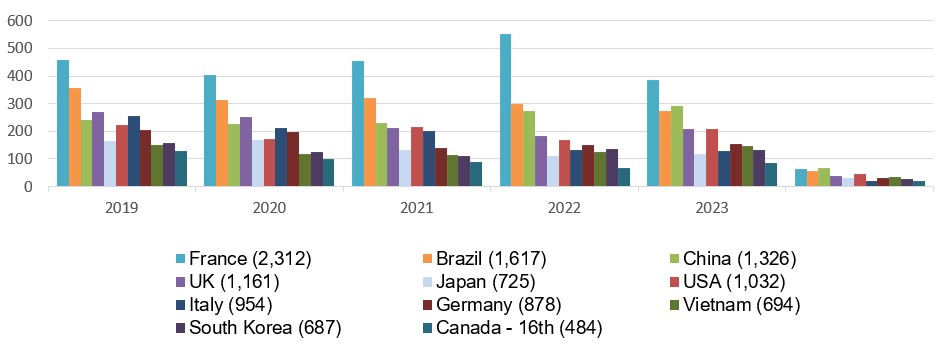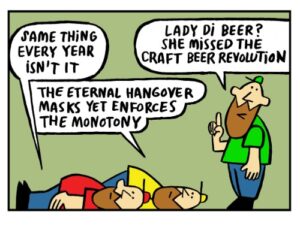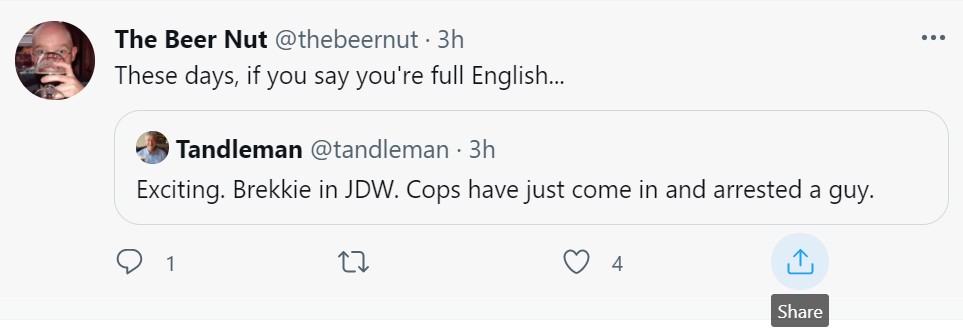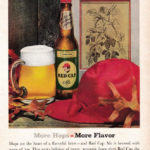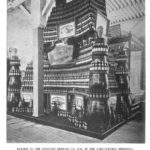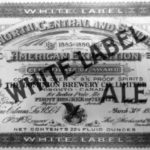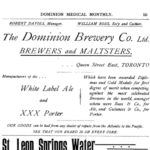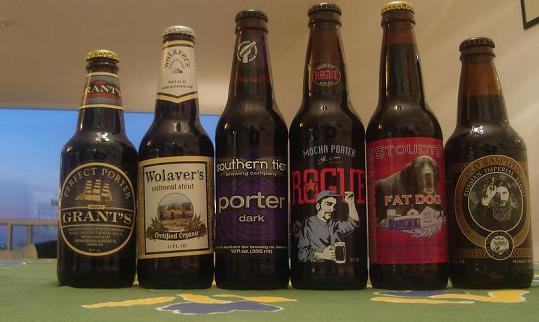 Took a trip east to Gan on Monday. Yup. I was out there day-tripping as I decided a few years ago that the first work day after the clocks change is gonna be a day off from here on out. And what did I see in wonderful Gananoque aka Gan? Well, I observed the law, that’s what I did. Meaning I saw this nice municipally financed and authorized and even installed sign that says you can drink in public in a nice park with a lovely view. I’m bringing a foldy chair and a few tins next time. Because it is the Law of Gan. What else can you do in Gan on a Monday in late winter? Well, the amusements never end if we are going to be honest.*
Took a trip east to Gan on Monday. Yup. I was out there day-tripping as I decided a few years ago that the first work day after the clocks change is gonna be a day off from here on out. And what did I see in wonderful Gananoque aka Gan? Well, I observed the law, that’s what I did. Meaning I saw this nice municipally financed and authorized and even installed sign that says you can drink in public in a nice park with a lovely view. I’m bringing a foldy chair and a few tins next time. Because it is the Law of Gan. What else can you do in Gan on a Monday in late winter? Well, the amusements never end if we are going to be honest.*
Speaking about drinking in public, wine writer Jason Wilson wrote this about an evening out in Logroño, a small city in of Spain:
At Bar Soriano, I get grilled wild mushrooms in garlicky sauce and topped with a skewered shrimp. At Bar La Travesía, I eat amazing tortilla española topped with a spicy pepper sauce. At Bar Donosti, I order a bite-sized dish of quail egg, chorizo, and pepper called cojonudos (which means “ballsy,” which is a compliment) followed by grilled foie gras on a slice of bread. At Bar Lorenzo, I get the famed Tío Agus, a skewer of spicy grilled pork on a bun with a secret green herb sauce. At Bar Sebas, I get the pimiento relleno de carne. At Bar El Perchas, I get either pig’s ear in a spicy sauce, or a fried pig’s ear sandwich (the only two items on the menu). At Tastavin, I eat quail escabeche or rabo de toro wrapped in puff pastry. At Bar Garcia, there’s always a plate of cecina or panceta curada. All along Calle Laurel and Calle San Juan, there are endless small plates of paper-thin jamón ibérico or grilled piparra peppers or skewers of olives and tinned fish.
What he wrote about got me all Pavlovian but then – later in the article when he got to writing about writing about wine – I realized the best bit of the article didn’t really mention the wine at all. It was local simple wine that accompanied these lovely plates of tapas. He then discussed how he was asked this by a researcher: “why is most wine communication so bad?” Go read his answer. Apply it to beer. Then ask yourself whether everyone is an actual expert.
Not unrelatedly, Eoghan provided a useful lexicon of words for being drunk that can be used in Brussels in Brusseleir, a Brabantian-Dutch dialect:
There are organisations that work to keep the language alive, and each year the non-profit Be.Brusseleir presents a “Brusseleirs van ‘t joêr” award to the best representative of the city. But it is a dying language, as native speakers either age out of the population or move outside Brussels in their retirement years. We may not be able to restore the language to its former glory, but that doesn’t mean we can’t still use it. So this weekend, instead of going to the pub drop into your local Stameneie. Not for a bière or a pintje, for a quiet Beeke. And if you stick around and have enough, you might even find yourself getting not drunk but a maybe a little bit Zat.
I quite like “Kousenband”! Never one to accept a kousenband, The Tand himself did spake this week and he spake unto ye and me of London, good and bad – including this lament:
My usual tactic here? Try the cask, pick the least bad one, then immediately wash it away with a pint of London Black. Works every time… Somewhat surprisingly, I feel, as mentioned above, you can trust the cask more in the one that isn’t called Craft, than the one that is, though that certainly wins as a pub. (I’ll draw a veil over the appalling beer in Fullers Trinity Bell next door to Cask. You could have poached an egg in the beer and it was flat as a pancake. Just the sort of stuff that puts people off cask forever, and not at all what you expect from Fullers managed house.)
Even more disappointedly, Kendell Jones of the Washington Beer Blog shared some tough news from the hop yards of that state with the closing down of Brulotte Farms:
Brulotte Farms is one of over a dozen grower-owners who make up Yakima Chief Hops, one of the world’s premier hop suppliers. The Brulotte family has farmed hops for six generations. Today, Yakima Chief Hops announced that Brulotte Farms is closing its doors after 81 years. The family farm is located in Toppenish, just outside of Yakima. “Yakima Chief Hops expresses our heartfelt gratitude to Reggie Brulotte for her commitment and passion for growing quality hops for brewers worldwide,” said a press release from Yakima Chief Hops. “Reggie has been an industry leader throughout her career and continues to be dedicated to the hop industry. Her contributions have had a tremendous positive impact on both the hop and beer industry…
Pete Brown posted another image of his weekly beer column in The Sunday Times and then applied some gently encouraging promotion for it on social media:
What’s wrong with mainstream? It’s a mainstream newspaper with a mainstream audience. But you know what? If I was writing a column for Craft Beer Wanker magazine, I’m not sure I’d change a single one. Sometimes, if they’re widely available, there’s a good reason for that.
Makes sense. He’s been sharing fairly newbie friendly primer level stuff so far – as it would have to be for a general audience. Perhaps at the other end of things, Pellicle‘s feature this week received high praise from David Jesudason:
This is brilliant. A fresh, journalistic approach to how a beer was ruined written in an authentic voice. Love it and you will too…
…which sorta laid on a bit of pressure, right? Fortunately the tale of the end of the Ringwood Brewery by Imran Rahman-Jones was as good as promised, tracing and placing events in the overall arc of brewing better beer:
Alan says Peter Austin would have been “ so proud” that a cask ale brewer like Marston’s had bought the brewery he founded. After all, Marston’s had successfully kept other acquisitions running, including Wychwood, Banks’s and Jennings. My early memories of Ringwood are from after the Marston’s acquisition, and the quality was still exceptional. The decline was not immediate, but over time—Neil says the personal touch was lost in favour of a more corporate environment. “Marston’s were more interested in selling you insurance, getting the price of your gas down and your rubbish disposal down than they were [selling] you beer,” he says.
The Guardian published a feature on Zahra Tabatabai’s Back Home Beer, an American of an Iranian background who is creating beers which reflect a samily tradition:
“My grandfather died when I was young, but my family always talked about him making beer and making wine,” said Tabatabai, 42, whose parents left Iran in order to attend university in Alabama with the intent to return home, just before the breakout of the Iranian revolution. Tabatabai’s parents ultimately settled in Georgia when she was five years old. Her Persian lager was specifically based on her family’s flavor memories. “I made a few batches of that beer, and they would give me feedback and then I’d go back and change the recipe,” she said.
The New York Times printed an interesting opinion piece this week on how one insider saw DEI initiatives failing at ABInBev:
I should have seen it coming. Many corporations were flexing their credentials in the growing diversity, equity and inclusion movement. But for me, the incident was a particularly telling example of what was going wrong with Anheuser-Busch — and an early sign that too many American corporations had forgotten who their customers were. To be clear, I believe that an employee base that has a diversity of thought — which is naturally associated with a diversity of ethnicities and backgrounds — is good for business. Different employees can better solve existing problems or identify new opportunities. But the massive corporate embrace of D.E.I. was always destined to fail, in large part because the movement was never well defined to begin with.
Some insta-grumbles about woke v. anti-woke but strikes me as this is a description of what was really playing out – and is still playing out – in heartless faceless corporate landscape. Even if it’s all fairly pathetic. Speaking of big beer, when is a beer Canadian? It’s an interesting question in these times of tariffs and retaliations:
Coors Light is an American brand. Molson Canadian is a Canadian one. But a can of either on the shelf in New Brunswick is produced in the same place: the MolsonCoors brewery in Moncton. MolsonCoors is headquartered in Chicago, but, as a publicly traded company, it has shareholders around the world. When N.B. Liquor began taking Kentucky bourbon and California wines off the shelf in their corporate stores, brands like Coors and Budweiser remained.
Sorta similarly, from the US perspective, there is an eduction process occurring on what local means to the business of beer and other products in these tariffs times – as in this report from Colorado:
Beer prices have recently gone up. Feguson credits the increase to the price of aluminum rising. The beer vendors are spreading the cost out amongst all of their products. So, though Ferguson’s company only buys kegs, he is seeing a $5 to $10 increase on everything he buys. “As a small business, I would say a micro business, our margins are so tight anyways that it does sting. We understand the way the world works though, and I think one benefit for us is because we buy only local Colorado products,” Feguson said. The price of coffee beans has also surged since they are imported to America. However, Colorado Craft Coffee and Beer House has not seen an increase from their suppliers. Ferguson says this is because everything they buy is roasted and brewed in Colorado, so it does “soften the blow.”
Finally and perhaps by way of contrast in both scale and certainty, Jordan wrote about a beer he helped create but really he talked about a cookie or rather the greatest frikkin’ cookie in the history of humankind:
It was, at one point or another, the best selling cookie in Canada. It’s constructed similarly to the oreo, but the oatmeal biscuits have a ridged diamond pattern criss-crossing them, and a touch of honeyed sweetness balanced by a little salt. The peanut butter filling is remarkably temperature stable. It’s not hard to see the appeal. The little devils are moreish, I think mostly due to the combination of sweet and savory. Christie eventually had factories across the city, including one at the far end of the Queen Streetcar in southern Etobicoke and one on O’Connor that is now Peek Freans. The company was purchased by Nabisco and eventually by Mondelez International. The Pirate Cookie has fallen from favour, largely due to the proliferation of nut allergies in the general population. It has not yet disappeared.
The trick was to separate the cookie while leaving that diamond of sugary peanut butter peaking through the cookie back with the filling. While you consider that, please check out Boak and Bailey every Saturday and Stan going strong again each and every Monday. Then listen to Lew’s podcast and get your emailed issue of Episodes of my Pub Life by David Jesudason on the (sometimes even but never) odd Fridays. And maybe The British Food History Podcast. And Phil Mellows is at the BritishBeerBreaks. Once a month, Will Hawkes issues his London Beer City newsletter and do sign up for Katie’s wonderful newsletter, The Gulp, too. The Share looks to be back with a revival. Ben’s Beer and Badword is out there with the all the sweary Mary! And check out the Atlantic Canada Beer Blog‘s weekly roundup. There is new reading at The Glass which is going back to being a blog. Any more? Check out the Beer Ladies Podcast. That’s quite good and they are revving up for a new year. And the BOAS podcast for the bro-ly. And the long standing Beervana podcast …except they have now stood down. Plus We Are Beer People. The Boys Are From Märzen podcast appears suspended as does BeerEdge, too. VinePair packed in Taplines as well. All gone. But not Ontario’s own A Quick Beer featuring… Michigan! There is more from the DaftAboutCraft podcast, too. All About Beer has sponsored trade possy podcasts and there’s also The Perfect Pour. Plus follow the venerable Full Pint podcast. And the Craft Beer Channel on Youtube. The Moon Under Water is gone which is not surprising as the ask was $10 a month. Pete Brown’s one cost a fifth of that – but only had the one post. Such is life.
*There was a large pike out by the hole in the ice, flopping as it dealt with the situation. And that is the USA in the background, by the way. Wellesley Island is there on the horizon.

